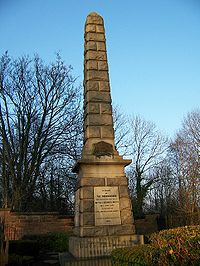Battle of Bothwell Bridge
| Battle of Bothwell Bridge | |||||||
|---|---|---|---|---|---|---|---|
| Part of Scottish Covenanter Wars | |||||||
 Monument to the Battle of Bothwell Bridge |
|||||||
|
|||||||
| Belligerents | |||||||
|
|
|
||||||
| Commanders and leaders | |||||||
|
|
|
||||||
| Strength | |||||||
| c.6,000 | c.5,000 | ||||||
| Casualties and losses | |||||||
| c.600 | few | ||||||
|
|
|||||||
The Battle of Bothwell Bridge, or Bothwell Brig, took place on 22 June 1679. It was fought between government troops and militant Presbyterian Covenanters, and signalled the end of their brief rebellion. The battle took place at the bridge over the River Clyde in Hamilton, South Lanarkshire near Bothwell in Lanarkshire, Scotland. The battlefield has been included in the Inventory of Historic Battlefields in Scotland and protected by Historic Scotland under the Historic Environment (Amendment) Act 2011.
Following the Restoration of King Charles II, the Presbyterians in Scotland were increasingly persecuted for their beliefs, and a small armed rising had been put down in 1666. Although some Presbyterian ministers were "Indulged" by the government from 1669, allowing them to retain their churches without having to accept Episcopacy, the more hard-line elements continued to hold illegal outdoor meetings, known as conventicles. These were often broken up by squads of government dragoons, including those led by John Graham of Claverhouse. On 1 June 1679, Claverhouse had encountered such a gathering near Loudoun Hill, but his troops were routed by armed Covenanters at the Battle of Drumclog, and he was forced to flee to Glasgow. Following this initial success the Covenanters spent the next few weeks building their strength, as did the government. Charles' son James, Duke of Monmouth was sent north to take command, and the militia were raised.
The Covenanters had established their camp on the south bank of the Clyde, north of Hamilton. The rebels numbered around 6000 men, but were poorly disciplined and deeply divided by religious disagreements. They had few competent commanders, being nominally led by Robert Hamilton of Preston, although his rigid stance against the Indulged ministers only encouraged division. The preacher Donald Cargill and William Cleland, the victor of Drumclog, were present, as were David Hackston of Rathillet and John Balfour of Kinloch, known as Burley, who were among the group who murdered Archbishop Sharp on 3 May. The government army numbered around 5000 regular troops and militia, and was commanded by Monmouth, supported by Claverhouse and the Earl of Linlithgow. The royalist troops were massed on the northern or Bothwell bank of the river Clyde on sloping ground that included a field that has since become known, ironically enough, as the Covenanters Field - not because the battle was fought there but because for many years it was the venue for a covenanters conventicle organised by the Scottish Covenanters Memorial Association.
...
Wikipedia

